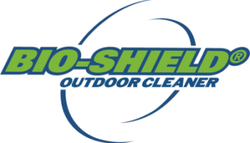Bio-Shield® Commercial and Contractor Supply
Bio-Shield® 220L Contractor Grade
Remove Moss, Algae and Lichen with Bio-Shield®
- Concrete and Asphalt Car Parks
- Paths, Paving and Driveways
- Airports and Airfield Runways and Hardstands
- Chipseal and Ashpalt Roads
- Solar Panels, Arrays and Farms
- Concrete Structures and Buildings
- Painted Steel Structures
- Glasshouses, Tunnel Houses, Windbreaks
- Colorsteel Roofs and Skylights - Industrial and Commercial Buildings
Moss, algae and lichen will grow anywhere there is sunlight and moisture, discoloring and damaging exterior surfaces on commercial and industrial properties, civic facilities, schools, retirement villages and general infrastructure.
These biological growths discolor and destroy protective coatings on building exteriors, and make concrete and asphalt driveways slippery and unsightly.
While waterblast has been the common method for cleaning it wont prevent regrowth, uses large amounts of water and labour and will damage many surfaces being cleaned.
Bio-Shield provides a cost effective, efficient and damage free method for cleaning moss, alga and lichens from any exterior surface.
BIO-SHIELD® 220L CONTRACTOR GRADE IS SUPPLIED TO COMMERCIAL CONTRACTORS ONLY
Bio-Shield® Contractor Grade - Price Comparison Table
| Product & Drum Size |
Diluted Total |
Cost to Buy |
Diluted Litre Cost |
|---|---|---|---|
| Bio-Shield® CG 220L |
9020L @1:40 |
$1395 | 15.4c |
| Enviro Chem 200L Moss & Mould |
3200L @1:15 |
$1265 | 39c |
| Enviro Chem 200L Moss & Mould |
4200L @1:20 |
$1262 | 30c |
| ChemMate 200L Moss & Algae |
4200L @1:20 |
$1195 | 27c |
| ChemMate 200L Moss & Algae |
5200L @1:25 |
$1195 | 23c |
Comparison Table Copyright 2025. All Rights Reserved - Bio-Shield Ltd
Bio-Shield 220L CG is Free Delivery in Auckland
North Island ChemCouriers + $135/drum = 16.9 cents per Litre
South Island ChemCouriers + $195/drum = 17.6 cents per Litre
Bio-Shield® Contractor Grade - Coverage Rates
Coverage Rates - Bio-Shield 220L CG makes up 9020 Litres of diluted Bio-Shield at the standard 1:40 dilution.
This dilution rate is suitable for the majority of contaminated surfaces except heavily blackened timber or terracotta.
27,600m2² at minimum coverage rate of 3m² per d/L - Initial Application - Good kill and clean up on all surfaces
45,100m2² at average coverage rate of 5m² per d/L - Maintenance Application on CLEAN CONCRETE
72,160 m² at maximum coverage rate of 8m² per d/L - Maintenance Application on CLEAN, NON-POROUS SURFACE
How to Successfully Apply Bio-Shield®
The key to success of Bio-Shield requires 2 conditions met during the application
1. Apply the Bio-Shield to saturate the growths and the surface being treated
2. Ensure the surface stays wet for 10 to 15 minutes through saturation of the initial coats



Bio-Shield® Case Study - 83% Cost Reduction Over Waterblast Cleaning
A large Regional Council in Northern Queensland previously ran a continuous 12 month program water blast cleaning hard surfaces to keep them clear of slippery black algae.
With a tropical climate and a 5 month wet season, by the time the water blast program was completed the back algae had grown back.
The council contacted us and arranged a trail application of Bio-Shield in place of water blasting.
Within 3 months Bio-Shield was confirmed effective and was selected to replace its water blast cleaning program.
The benefits provided by Bio-Shield included
- 83% reduction in costs of a 2 month Bio-Shield application program by reducing labour, water, fuel, equipment costs.
- The treated surface stayed clean for at least a full 12 months in a tropical environment
- No waterblast damage to council assets.
- Minimise disruption from waterblast operations including noise, water overspray and dirt.
- Fully Bio-degradble, quickly breaking down into naturally occurring compounds.
Limitations of Bio-Shield®
Bio-Shield will kill moss, algae and lichen on any surface, however to effect a complete clean up the surface must be exposed to rain and weathering. If the treated surface is frequently shaded by overhanging trees or buildings or the treated roof surface is under TV aerials or below downpipes from upper roof levels, the surface may need more frequent applications to keep the surface clear of growth.
The length of time between applications will vary with the substrate and micro-climate around the treated surface.
Bio-Shield® Environmental Information
The active ingredient in Bio-Shield has a 60 year history of safe and effective use as a surface steriliser, including in the food production, hospitality and brewing industry where it is used as a no rinse biocide.
Bio-Shield is fully bio-degradable when in contact with organic matter, diluted down and flushed by rainfall on the treated surface. Dilution by 10mm of rainfall on a 1 m2 of treated concrete will dilute the active ingredient down to well below the LD testing levels. When rainfall runoff from untreated areas is combined with runoff from the treated area, as little as 1mm of rainfall may reduce the level of active ingredient to below LD levels.
In addition, Bio-Shield is not genotoxic, has a half life of 0.5 days and breaks down when in contact with organic materials into naturally occurring compounds.
All ingredients in Bio-Shield are listed on the USA EPA Safer Chemicals list.



